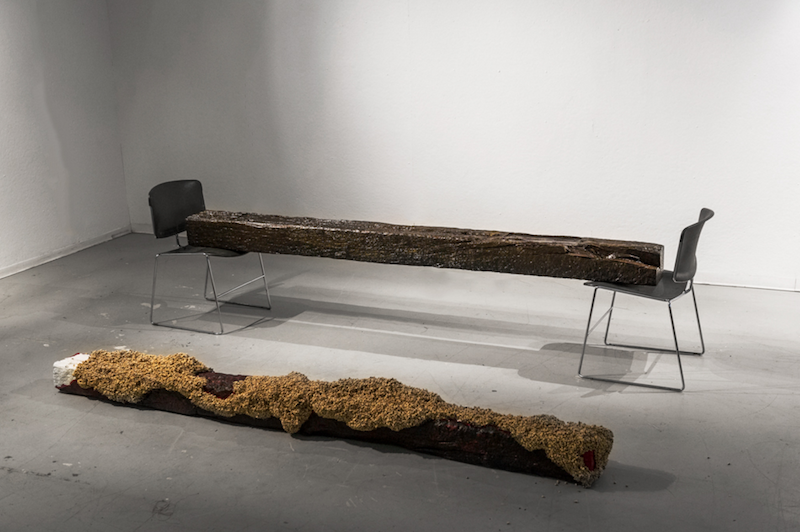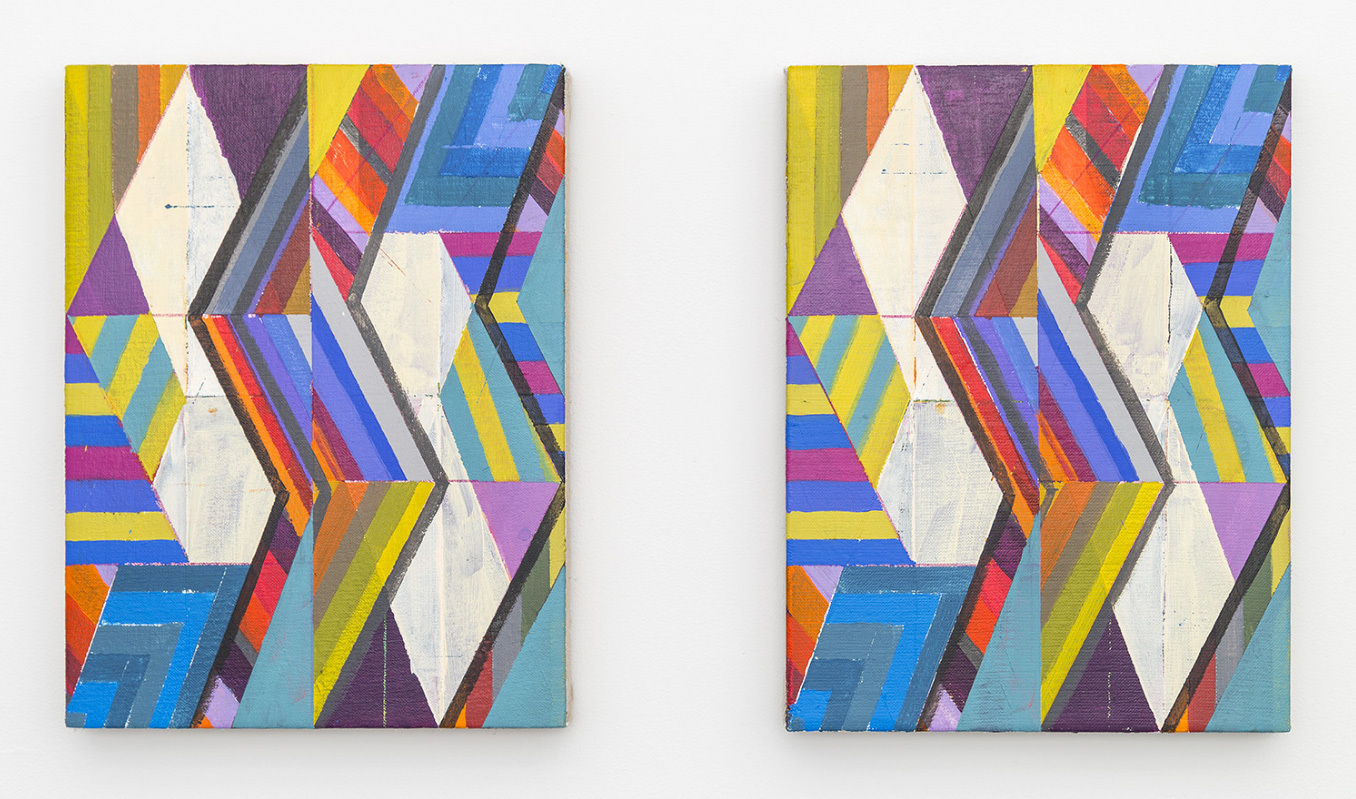Each summer on Fire Island, a tiny community off the coast of New York situated just below Long Island, five LGBTQ artists are invited by Chris Bogia and Evan Garza, the co-founders of Fire Island Artist Residency, to spend a month living and working together. For four weeks, their home is Cherry Grove, an idyllic, remote area of the island only accessible by boat, where artist Chris Bogia tells me “it is roughly a city block length walk from the bath to the ocean”.
Fire Island is the oldest gay town in the country, Bogia explains when I ask him why he chose the location. For decades, it has been historical site for queer art making, housing writers such as Tennessee Williams and Frank O’Hara and artists including Robert Mapplethorpe and Paul Cadmus.
“We wanted to honour that tradition of culture-making by queers by bringing an even more diverse group of young talented people to contribute to that legacy,” Bogia tells me. “A generation of gay artists were lost during the AIDS crisis. Mentors from that generation are fewer than we’d like, and so creating a situation that brings folks from that generation to commune with emerging artists is an important way of attempting to repair some of the cultural collateral damage from AIDS.”
In 2011, Chris Bogia and Evan Garza opened submissions for LGBTQ artists from America and across the world to come and live in the house then named Hard Times in the country’s first LGBTQ artist residency. Five artists in residence were picked from a list of applicants by a team of staff and art world figures. During the month they lived in Cherry Grove, artists would work in the studio where they would be visited by celebrated lecturers from across the country. Twice a week, they would also attend evening events at Community House — one of only three nationally recognised LGBTQ historic sites — and, on other evenings, artists would be free to explore Fire Island’s thriving LGBTQ community, going dancing or to the islands drag shows.
When I ask Bogia about FIAR’s most memorable resident, he tells me about Babirye Leilah, who came to Fire Island last summer from Kampala, Uganda where she had recently been outed as gay by a local tabloid. “Her work and her artistic voice had largely been silenced where she was from, and it was a privilege to watch her thrive and make work unencumbered by fear,” Chris explains. Babirye subsequently decided to stay in the US and seek asylum. Although attitudes towards the LGBTQ community in the US are generally shifting slowly towards something like acceptance, in June the world witnessed the massacre of 49 people and the wounding of 53 others in gay nightclub Pulse in Orlando by American security guard Omar Mateen. The fear felt by Babirye Leilah rippled through LGBTQ communities across the world. “We were all reminded that LGBTQ people, people of color, women, any “other”… Are all vulnerable populations,” Chris says. “FIAR wants to give voices to the emerging visionaries who will create the visual culture that we want to make real so that in the future our voices and our communities just get stronger.”
From the 420 artists that applied for residency in the FIAR house this August, Chris Bogia, Evan Garza, art experts and FIAR alumni and staff chose Paolo Arao, Edie Fake, Wilder Alison, Jesse Harrod and Derrick D’Von Woods-Morrow. During their time on Fire Island, the five artists will be visited by lecturers Tom Burr, Angela Dufresne, Jeffrey Gibson and Eileen Myles, and take part in a special collaboration with Visual AIDS featuring Tom Bianci. i-D meets the five artists as they prepare to begin their residency on the iconic Fire Island to talk about work, sex and what it means to identify as queer in 2016.

Tell us about yourself.
I grew up in Canada and went to undergrad in Toronto and Halifax. I moved to the States to go to graduate school at SAIC. I have been told I am funny and silly and that I have really perky tits. I make sculpture, drawings and videos.
Why did you apply to be part of the FIAR project?
I have wanted to go to this residency for a while. Since coming to the US, I have moved around a lot for work and have not really had the chance to be a part of a queer community in an ongoing way. I so desperately miss my amazing queer community in Canada. I am often the only punk rock queer in the room and the idea of spending a month with other artists who think, feel, and identify with queerness in one way or another is really exciting. To not have to explain what it means to be queer or genderqueer feels like the best gift. I have also had a number of friends who have attended FIAR and they have all said it was magical – that’s enough of a selling point for me! Besides who wouldn’t want to go to an island and make art with other smart engaged queer and trans folks?
What does it mean to identify as LGBTQ in 2016?
That is like asking what it is like to be you in 2016? By that I mean I am just this person and I just exist. I think that there is a myth that it is easy to be queer and out now, and that because of gay marriage we are all just peachy, but of course that’s absolutely not true. I have and continue to experience so much heterosexism and homophobia and there are times it makes me want to curl into a ball. But there are other times it fuels my work and passion. It is hard to ask so close to the Orlando deaths. People have no idea how unsafe they are not just walking down a street, but in a bar that is supposedly a safe haven. And I am white person, I have privilege… The US needs to wake the fuck up and we need a revolution. But don’t quote me.
Introduce yourself.
I live between Brooklyn and Vermont. I am an interdisciplinary artist, art worker, teacher, city dweller, and nomad. I am from the woods and I also grew up in the plains. I was raised by an engineer and a quilter to make all kinds of things.
Tell us about your work.
My work emerges in a variety of formats, including painting, silkscreen, video, music and text. Lately, I aim to make paintings that engender loops of apprehension, mis-registration, and refusal of their signifying gestures, of the signs or near-signs that they contain. I am less interested in arriving at one meaning in my work, than in getting close enough to the possibility of many meanings without closing them down.
Do you identify as an LGBTQ artist?
This question is hard to answer because the answer isn’t no, but I am not interested in claiming a coherent subjectivity. Queer artists are my favorite people, and I am so proud and inspired by this community’s deep engagement with art and difference.

Where do you live?
I live in the California High Desert, out around Joshua Tree National Park.
How does sexuality play into your work?
In my drawings I use ecstatic architecture and vivid geometry to draw spaces for queer (and specifically trans) identities and histories. Each piece evolves from free associations between bodies and architecture, from the physicality of rectal doorways and bloody pools to psychological gestures like vibrating pattern and winding, maze-like walls. I’m always trying to go out on a limb in envisioning what Queer Space can look like, so the finished drawings become these Winchester Mansion-style building-riddles about identity and sexuality.
What does it mean to identify as LGBTQ in 2016?
I don’t think there’s any singularity to what it means. A lot of work has been done for trans and queer civil rights and safety, and a whole lot of work still needs to be done in a multitude of directions: the decriminalisation of trans bodies, environmental justice, racial justice, healthcare and housing access — the struggles all continue.

What will you be working on during the residency?
I will be working on an epic project called “Yearbook”. For this project I paint one 12 x 9 inch painting every day for an entire year. I give myself only one hour to complete each painting. The self-imposed time restriction enables me to focus on the most important elements to convey in each painting and be present in that given moment. Mistakes, failures, successes and indecisions all share the same space… I’ve made a habit of texting a picture of each finished “yearbook” painting to my husband every morning. And it’s become somewhat of an extended love letter to him. Besides exhibiting all 366 paintings in its entirety (it’s a leap year), I plan to publish this project as a book.
Do you identify as an LGBTQ artist?
Yes. But my work doesn’t always overtly look or reflect this.
How does sexuality play into your work?
I have an ongoing series of diptych paintings called “We Belong Together” that approaches abstraction from a queer perspective. Shown in pairs, these intimately-scaled paintings are reflections that are equally about sameness as they are about difference. They’re also very much about the act of looking and shifting perceptions. And also about being in tune with someone you love. I affectionately refer to them as my “same-sex” paintings.

Tell us about your work.
My work — photography, performance, social practice, sculpture and installation — focuses on the problem of being an object of other peoples expectation, while at the same time, struggling to locate a sense of self-hood beyond those expectations. I draw from personal history, and examine the “locations” of homoerotic activity and their relation to the mainstream ideals of masculinity circulating in American visual culture.
What will you be working on during the residency?
I find that the energy on display in locations loaded with sexual openness and exploration make for promising but sometimes challenging investigations. In the case of Fire Island, and its history of providing a deluge for queer spaces, I expect to explore any way I can — some sculptural, performative, some writing and photographic. I am heavily interested in photographing representations of spaces I consider the in-between, neither here nor there, or anywhere depending on who’s watching or who’s cruising — places of exhibition and of dynamic transference around the FIAR and especially within the Fire Island community. I just want to be open to what slaps me in the face, and what I accidently stumble upon and see what comes of it.
Do you identify as an LGBTQ artist?
Yes. I consider myself queer. I know there are a myriad of terms thrown around out there. I recently saw a chart that had fifty plus representations of how to identify outside of the norm. My issue here is that once you try to identify outside of the norm, you allow for some normative narrative to pervade everything you do. Deep down, I prefer to deny that a normal even exists, and yet the use of the term “queer”, which is yet another term reclaimed, once a term used by The Dreamers to exclude, is now used as an inclusionary term for those wishing to use the title and has a beautiful ring.
Credits
Text Bryony Stone
